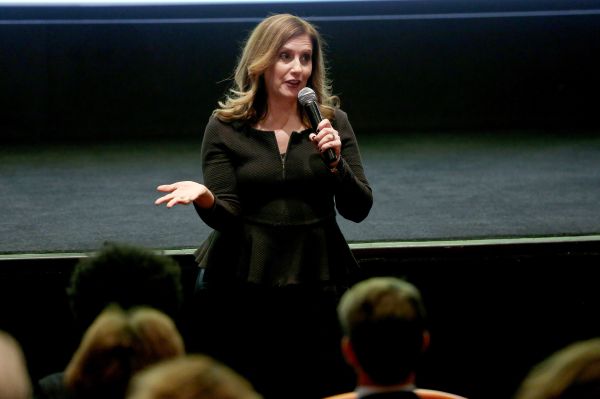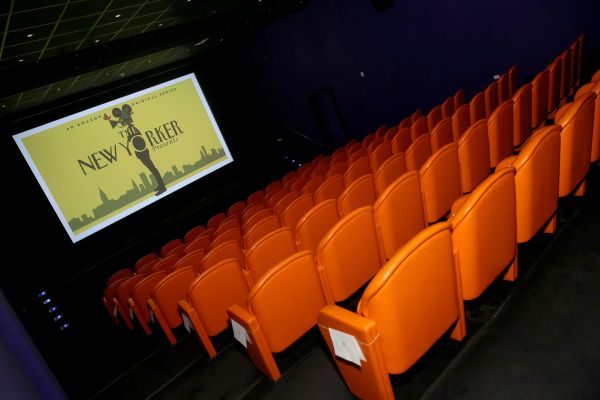The New Yorker is giving audiences a new way to digest their content via The New Yorker Presents, a new series that premieres on Amazon today. Much like the magazine, the show is a mish-mash of non-fiction, fiction, poetry, and cartoons. With the blessing and collaboration of editor David Remnick, the show’s executive producers include Kahane Cooperman (The Daily Show) and documentarian Alex Gibney (Going Clear). The show works with New Yorker writers (Ian Frazier, Miranda July, and Nick Paumgarten to name a few) and their stories and puts them into the hands of well regarded filmmakers (Steve James, Shari Springer Berman and Robert Pulcini and others) to recapture their stories in a visual medium. What results is a unique television show that combines documentary, non-fiction shorts, cartoons, and poetry, as well as glimpses into the New Yorker offices and the nooks and crannies of the city itself.
One episode features a documentary from Alex Gibney about how the CIA kept pertinent information from the FBI that could have prevented 9/11, a fictional short of how exactly author Honore de Balzac (played by Paul Giamatti) drank his 50 cups a coffee a day, a cartoon from Roz Chast, a glimpse at the work day of New Yorker fact checkers, and a short doc on people who suffer from “Truman Show delusion.” In another, you’ll learn that the Naked Cowboy was anorexic in his youth and has a sweetheart of a father, and that Andrew Garfield is gifted when it comes to performing poetry.
I spoke with Cooperman about transitioning from The Daily Show to The New Yorker, how the show captures the feel of the esteemed magazine in a new medium, and the heartfelt stories we can expect in the series.

How was it transitioning from The Daily Show to The New Yorker Presents?
I was fortunate that the day Jon Stewart announced on the air that he was going to be leaving The Daily Show, Alex Gibney, the filmmaker, reached out to me. I did’t know him all that well, but we had certainly met a few times. He said, “I have this rather extraordinary opportunity here.” He knew that, in addition to The Daily Show, my background was in filmmaking and documentary filmmaking specifically. I said, “Yes,” in one second because it sounded so interesting and so compelling, the idea of short films made from New Yorker content. I was incredibly excited. I went on my first round of job interviews for the first time in 18 years, which is how long I had been at The Daily Show. I interviewed with Alex and also Amazon and Condé Nast Entertainment and finally with David Remnick. Lucky for me, I got the job. I left The Daily Show on a Friday, had the weekend, then jumped right into this. I didn’t get a break, but I think that might be a good thing.
How is the working environment different for you?
I feel like it’s been an incredibly positive experience because everyone really cares about this show and I think, out of the gate, there’s such high regard for The New Yorker. The standards for that magazine and the history of it compel you to do your absolute best and work really hard. You just want it to be to their standards. Everyone’s on the same page about that, and that’s everybody, from myself to the production assistant to our outside filmmakers to our in house filmmakers, to our collaborators at Amazon, Condé, Jigsaw, and The New Yorker, the staff and writers, too. It’s an insane collaboration and giant trust exercise to get this done. It’s a very ambitious project, so everyone’s worked really hard. But it’s also been a very positive super collaborative experience.
It’s really a unique and compelling show, with the merging of so many genres and topics.
I’m thrilled that you feel that way. Each episode has to be its own entity, and I think there isn’t quite anything like this. I’d like to think of it as a way of reinventing the way a news magazine can be. Obviously it’s not just news, but that kind of format. I think this is something new. It’s not hosted, there’s not one specific way we’re telling people to look at things. We’re using the voices and visions of a lot of different artists and filmmakers and there’s a lot of different types of films. There’s nonfiction and fiction, there’s comedy, there’s poetry, there’s cartoons, just like the magazine. So, it’s a very unusual show.
Have you seen Pop-Up Magazine?
No. Since I left The Daily Show in April, I haven’t seen anything. [Laughs.] I’m embarrassingly out of it. I have to check it out.
It’s a live-magazine performance, they never record it or anything. But it started in San Francisco and they’ve also done shows in Los Angeles and other cities.
Oh, so it’s a live experience. Oh my gosh, this sounds amazing. I thought it was some magazine and I was feeling embarrassed that I had never heard of it before. Sounds incredible, I’m in.

You would love it. It brings a magazine to life, much like The New Yorker Presents. I’m curious about the idea of visualizing magazines in new ways. Could this show spark ideas for other magazines?
I think it could. We’re not really trying to be an exact reflection of the magazine. We’re using the magazine as our inspiration and our starting point with the blessings of David Remnick and his writers and editors at the magazine. But I think there’s so much packed into every single issue of that magazine, not all of which, by the way, translates to a visual medium. But a lot of it can. And the other great and compelling thing about this particular series is that The New Yorker didn’t bind us to every detail of every story. They allowed the filmmakers and us to riff off these stories and saw the stories as starting points, but then let the filmmakers bring their own vision to it, or take part of an article then expand on that. With The New Yorker, it’s particularly interesting because it combines non-fiction and fiction. A lot of magazines don’t do that, so that gave us the license to have all different types of storytelling all in one show.
Was there a discussion of how you wanted to evoke the feeling of The New Yorker and have that come across in the show? Because it’s interesting, when I watched the show, the feeling is the magazine. How did you do that?
You don’t even know, that’s the biggest compliment that I could ask for. One of my personal, creative challenges was to acknowledge that all of these pieces are very different from each other. Every film is on a different subject in a different style. There’s fiction, there’s non-fiction, and they’re all done by different filmmakers, so they look and feel different. There’s a challenge in trying to make them feel like they are of the same universe. Even though these stories are so different, what ties them together? I came up with this idea that we dip into all of these smaller, shorter-form worlds. The New Yorker is where it all starts. You see that some of our episodes include quick, behind the scenes, very cinematically shot vignettes at The New Yorker. But The New Yorker is an icon in and of itself of this city, New York City. I thought that might give us the license to explore New York a lot, in the same way that the magazine opens windows into all of these different worlds, I thought the show could do the same. In that way, the connective tissue became the cinematic looks behind the doors and windows of New York City with our around town interstitials that are really beautifully shot.
Is there a story from the series that resonates most with you? I know, that’s sort of an unfair question.
It kind of is. [Laughs.] It’s so hard to say one. I would say my feelings about these pieces can change on a day-to-day basis. I’m compelled by all of the stories in the series. But my relationship to them changes depending on what’s going on in the world or how I’m feeling. There’s one character in particular I’m comfortable saying really sticks with me and that’s the character Cassandro in Roger Ross Williams’ film “The Man Without a Mask,” based on the article [by William Finnegan] of the same name. He’s a lucha libre wrestler who’s an out-of-the-closet gay man who grew up in a very macho society and somehow found his place in this world of lucha libre wrestling. I find him to be one of the more resilient and compelling and moving characters ever. He really just stuck with me. I’m very moved by his story and his strengths.






